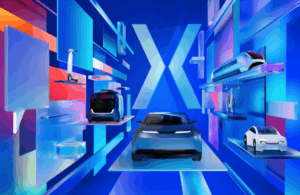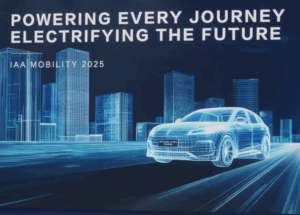MUNICH / BEIJING ŌĆö At the International Motor Show (IAA) in Munich this September, Chinese automakers such as BYD, Xpeng, and Avatr arrived in force, showcasing the rapid rise of ChinaŌĆÖs electric vehicle industry. Never before had so many carmakers from the PeopleŌĆÖs Republic attended the German fair. Yet what they displayed was only a fraction of the cars currently flooding the Chinese market.
There are now more than 100 car manufacturers in China ŌĆö a staggering number even for a nation of 1.4 billion people, many of whom still donŌĆÖt own a car. For most analysts, the math is simple: there are far too many players for the market to sustain.
A Market Glut Turns into a Price War
The result of this overcapacity has been months of deep price cuts as automakers compete for survival. With many consumers choosing to save their money ŌĆö for old age, education, or simply uncertain times ŌĆö carmakers are slashing prices to stimulate sales. Today, a basic electric vehicle in China can sell for less than Ōé¼10,000 (about $10,800).
The consequences have been severe. According to Deutsche Bank, profits in ChinaŌĆÖs auto industry dropped by 33 percent between 2018 and 2024, even as sales volumes grew by 21 percent. Analysts describe the situation as ŌĆ£an extreme and ruthless competition.ŌĆØ Profit margins have all but vanished, and industry insiders warn that many companies may not survive the next two years.
Deflation Deepens the Crisis
The car industryŌĆÖs troubles mirror broader economic challenges. For three consecutive years, ChinaŌĆÖs producer prices ŌĆö the prices manufacturers charge for goods ŌĆö have been falling, suggesting that deflation is taking hold. Although the pace of decline eased slightly from 3.6 percent in July to 2.9 percent in August year-on-year, the underlying problem persists: with prices expected to fall further, consumers and companies alike are delaying spending and investment.
ŌĆ£Deflation is both symptom and cause,ŌĆØ said an economist at Nomura Holdings. ŌĆ£Manufacturers keep cutting prices to stay afloat, but that only worsens the cycle of weak demand.ŌĆØ
Government Support and Overproduction
The roots of the problem lie in ChinaŌĆÖs state-led industrial policy. Through its five-year plans ŌĆö the latest set to expire at the end of 2025 ŌĆö Beijing has long directed subsidies toward strategic industries, from electric vehicles to solar energy. Alongside direct funding, companies benefit from tax incentives, cheap loans, and low-cost land allocations.
Because ChinaŌĆÖs provinces compete with one another to produce local champions, nearly every region has its own ŌĆ£national priorityŌĆØ manufacturer. The result: too many factories producing too much, with too little demand to absorb it.
ŌĆ£China has industrialized faster than it can consume,ŌĆØ observed a trade analyst at OECD. ŌĆ£Now the excess is washing over global markets.ŌĆØ
The Solar Industry: Another Victim of Success
The problem extends beyond cars. ChinaŌĆÖs solar industry, once a global environmental success story, now faces the same overcapacity crisis.
By some estimates, Chinese manufacturers produced enough wafers, cells, and modules last year to meet global demand until 2032. This oversupply has crushed international competitors.
Swiss solar panel maker Meyer Burger recently blamed ŌĆ£a challenging competitive environment caused by extensive low-priced imports from ChinaŌĆØ for its financial distress. In early September, the company shut down operations at its plants in Saxony and Saxony-Anhalt, cutting 600 jobs.
While Beijing might view such foreign withdrawals as a sign of industrial dominance, experts note that Chinese producers themselves are barely profitable. ŌĆ£If everyone loses money, no one wins ŌĆö not even China,ŌĆØ said Frank Nolden, a European solar market consultant.
Xi JinpingŌĆÖs Call to End ŌĆśDestructive CompetitionŌĆÖ
ChinaŌĆÖs leadership is increasingly aware of the dangers. President Xi Jinping has publicly warned against ŌĆ£destructive discountingŌĆØ and ŌĆ£disorderly price competition.ŌĆØ In response, Beijing has amended its Anti-Unfair Competition Law and encouraged industries ŌĆö from autos to solar ŌĆö to limit output.
The central government has also told provincial authorities to stop propping up failing companies. Still, Beijing aims to avoid a massive wave of bankruptcies that could destabilize the job market.
Global Ripple Effects
International reactions have been swift. In Europe, automakers and policymakers are growing anxious about the influx of cheap Chinese electric vehicles, prompting the European Commission to launch an anti-subsidy investigation earlier this year. In the United States, trade officials are debating whether to tighten import tariffs on EVs and green technologies sourced from China.
Meanwhile, economists warn that ChinaŌĆÖs internal deflation and overcapacity may export economic stress worldwide, driving down global prices ŌĆö a phenomenon not seen since JapanŌĆÖs ŌĆ£lost decades.ŌĆØ
A Balancing Act Ahead
ChinaŌĆÖs industrial might remains formidable. Yet the crisis in cars and solar panels reveals a paradox at the heart of its growth model: the same state-led strategies that fueled its rise are now threatening to undermine its profitability.
As Beijing tries to engineer a ŌĆ£soft landing,ŌĆØ the rest of the world is watching closely ŌĆö wondering whether ChinaŌĆÖs drive to dominate the green economy can survive its own success.


